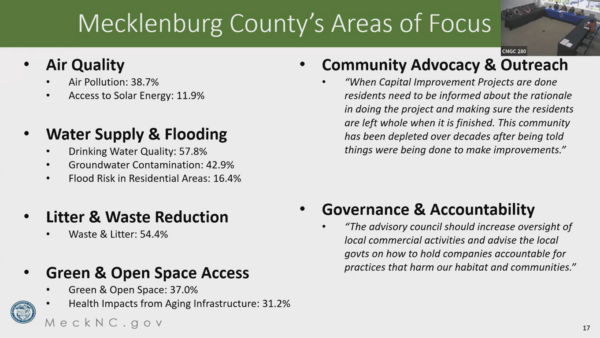Environmental Justice framework takes shape

This week, the Environmental Stewardship Committee held their March meeting. There was only one item on the agenda: the Environmental Justice Framework. Couldn’t make the meeting? Here’s a recap!
Key takeaways
- Environmental justice (EJ) brings the concept of the environment to our everyday surroundings and as a force that affects the lives of underprivileged communities the most.
- Mecklenburg County staff are working on the beginning phases of an Environmental Justice Framework to inform government programs.
- Through data analysis and community engagement, county staff have identified six areas of focus for the Environmental Justice Framework.
- County staff will continue to do research and community engagement based on feedback from the Environmental Stewardship Committee before bringing the draft to the full Board of County Commissioners.
Read on for more information on each of these items and more!
Environmental Justice Framework
In March 2021, the Board of County Commissioners officially supported the creation of an Environmental Leadership Action Plan. One of the pillars of this plan is expected to be the Environmental Justice Framework (EJF), which county staff have been drafting for the past year.
But what is environmental justice (EJ)? EJ takes the concept of “the environment” and places it where we live, work, and play. In other words, the environment doesn’t only exist in state and national parks – it is all around us every day. County staff clarified that they see the government’s role in EJ as fostering EJ “through processes that address, mitigate, and amend past injustices while enabling proactive, community-led solutions for the future.”
To kick off the planning process, city staff hired a consultant who looked at 120 GIS data layers and 555 census block groups to create three indices:
- Overburdened Quality of Life
- Within the county, where is the worst quality of life?
- Access to services and community resources rank
- Do all residents have access to resources the county offers?
- Environmental burdens rank
- Where are burdens from environmental factors like flooding, pollution, and urban heat felt most strongly?
Armed with data and these questions, county staff held 10 community engagement sessions and added EJ questions to a larger country-wide survey that is specifically designed to capture a representative sample of the population. When only 50 people showed up the community engagement sessions, staff conducted a second round of outreach with a different strategy: presenting to 13 different neighborhood associations, churches, and local groups. Overall, staff were able to engage 500 residents in the EJ discussion.
From these interactions, staff identified six areas of focus for the EJF, each with a few goals and strategies for each goal. For more details on each goal and strategy, we recommend watching the meeting recording or viewing the meeting agenda when it is posted. The six areas of focus are:
- Air Quality
- Water Supply and Flooding
- Litter and Waste Reduction
- Green and Open Space Access
- Community Advocacy and Outreach
- Governance and Accountability
Staff were clear that the focus areas, goals, and strategies are a draft. However, in order for the work to move forward and dive deeper, the full Board of County Commissioners will need to show support. Staff had intended to bring this presentation to the county commissioners’ April 9 Public Policy meeting, but the Environmental Stewardship Committee recommended they answer the following questions first:
- What actionable items can the county take to ensure that residents are aware of this work and have an opportunity to voice their opinions?
- What is the enforcement mechanism for the EJF?
- Staff need to take a deeper look at the data to show exactly where the disproportionalities are by district. For example, where specifically are people seeing a difference in water quality across our county?
- What is the relationship between EJ hotspots in our county and chronic illness?
Mecklenburg County is long overdue for a plan that addresses environmental justice. We are pleased to see staff and commissioners having this much-needed discussion and we anticipate more hard-hitting questions and thought-provoking conversations as the EJF takes shape.
More information about the EJF and community engagement opportunities are expected in the next few months. We’ll be sure to let you know as they come available. Stay tuned!
THANKS FOR READING!
As a nonprofit, community support is essential for us to keep doing what we do — including providing free articles like this. If you found this article helpful, please consider supporting Sustain Charlotte.
Want to stay in the loop? Subscribe to our weekly newsletter and follow us on Instagram, Facebook, and Twitter.
